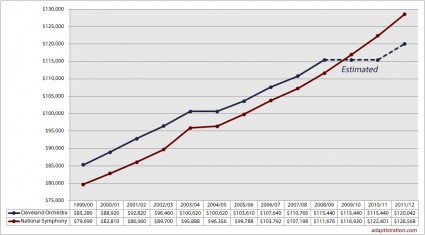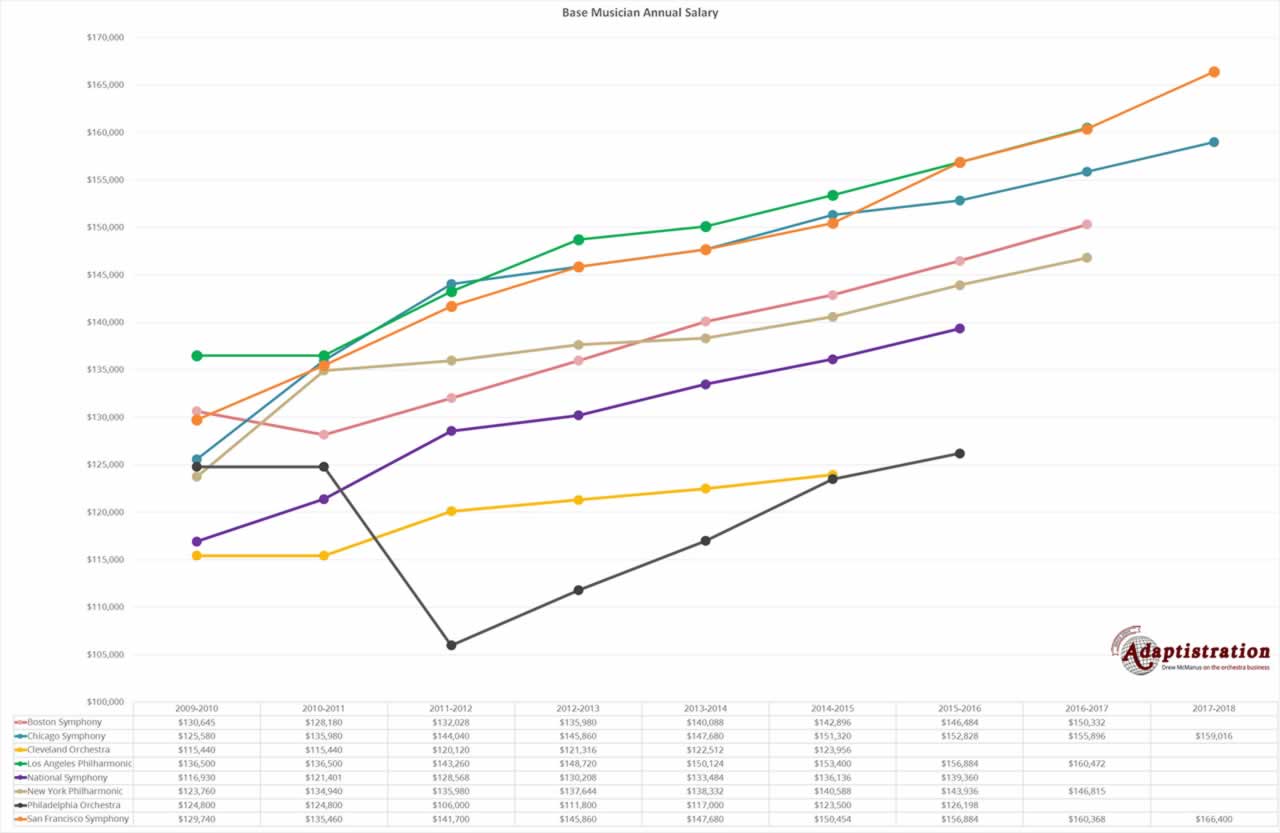Although comprehensive details in the form of the final agreement language won’t be available for a few weeks or more, some aspects of the new agreement have been made public. Based on information included in a press statement, here’s what can be discerned:
- Length: 9/2009 (retroactive) – 8/2011; or the 2009/10, 2010/11, and 2011/12 seasons.
- Compensation: Freeze for the first two years, then a 3% raise in the first half of 2011/12 and an additional 2% raise in the last half.
- Musicians will not have increased medical insurance premiums (this point was updated @ 9:12am CT).
In addition to these items, the statement indicates that the musicians will donate up to 10 services “which will provide cost relief and additional revenue for the Musical Arts Association.” It isn’t entirely clear how that will unfold but assuming that it is something occurring on an annual basis and is an across the board service donation schedule for the entire membership, that would amount to approximately 2% of their annual compensation.
So assuming all things are equal (and that’s a big assumption without the actual agreement in hand), the musicians agreed to incorporate two-fifths of management’s proposed pay cut without actually having the pay cut appear on paper in the form of reports and job announcements. For executives, this is something that happens on a fairly regular basis in the form of a predetermined contribution in lieu of an official pay cut; however, it comes with the added benefit of being able to deduct the contribution as a charitable donation.
Since a picture is worth a thousand words, here’s a quick chart comparing the base musician compensation history of the Cleveland Orchestra with the National Symphony Orchestra.
Regular readers will recall the reason behind comparing these two ensembles from the article on 1/11/2010 which examined an updated analysis of top tier base musician compensation. In that article, it was hypothesized that the Cleveland Orchestra’s base musician compensation may fall below the National Symphony Orchestra and pull even farther away from their traditional compensation peers. Assuming the estimated figures in the above chart are accurate to within +/-2%, it looks like for the first time in the Cleveland Orchestra’s history, this element of the organization will be closer to ensembles outside their traditional peer group consisting of Boston Symphony, Chicago Symphony, Los Angeles Philharmonic, New York Philharmonic, Philadelphia Orchestra, and San Francisco Symphony.
Assuming there are no major changes in base musician compensation levels in extended peer groups, the Cleveland Orchestra will be in the middle of a new tier immediately below that group consisting of the National Symphony Orchestra and Pittsburgh Symphony Orchestra (and possibly Detroit, but that won’t be known until that group concludes their current labor negotiations).
Rest assured, we’ll revisit the above information once additional details have been made public.




Drew,
Fill me in on why the relative cost of living doesn’t get factored in to orchestra wage comparisons? There are several CofL calculators available on the web, and if you use them you could conclude that Cleveland enjoys the highest compensation of all American orchestras – because a dollar goes so much farther there than in other cities. If you look at these cost of living calculators, the biggest factor by far is housing. You’d probably want an economist or agency to provide the numbers and not rely on an internet-based calculator, but I think we all know that $500,000 buys a large, attractive home in the Heights and a studio in Manhattan or LA.
My take on Cleveland is that the real thorn in their side must be Pittsburgh: relatively nearby, with wages rapidly approaching theirs and a similarly low cost of living.
Best,
E
That’s a good question Elaine and one that’s been popping up regularly in the extended Cleveland discussion. Perhaps one of the most common components here is that orchestra musicians are expected to shoulder a much larger personal expense that lasts the entire length of active employment in the form of instrument costs. Unfortunately for players, instrument dealers don’t take into consideration where they live and work when setting prices.
To make the matter even more complicated, those costs vary wildly from one instrumental section to the next and can cost in the lower six figures (at the lower end) though mid six figures (at the higher) all the up to seven figures (at the extreme). Consequently, in order to conduct the sort of comparison I think you’re describing (and correct me if I’m misinterpreting your question), you would have to take those factors into consideration. I have yet to encounter any sort of online calculator capable of considering those variables or for that matter, any customized study (if anyone is aware of one, I’d love to review it).
Additionally, it is an assumption that some of the larger ticket items like homes are what musicians would allocate personal financial resources toward to begin with. Add to that, traditional cost of living calculations are based more on Keeping up with the Jones’ aspects which served as one of the dominant contributing factors to financial abuses that led to the downturn in the first place.
In the end, contemporary variables in cost of living calculations such as the cut and dry McMansion=desirable are more of a non sequitor (especially in this field). When combined with the unique financial responsibilities associated with a professional orchestra musician career path, those considerations become far less meaningful.
Finally, the relative cost of living issues aren’t factored into the executive, music director, and concertmaster elements of the compensation reports either. As a result, the compensation evaluations here at Adaptistration are as even of a playing field as is possible.
Ultimately, the entire compensation discussion is only a side bar of the larger conversation that is assigning comparative value from one orchestra position to another. This applies not just to musicians but administrators as well. I have yet to encounter a meaningful job satisfaction study for either employment sector. As a result, traditional benchmarks continue to dominate the business when attempting to assign overall value from one organization to the next. And until some reasonable research and efforts are directed toward those efforts (attention philanthropic institutions) we’ll never really know if those traditional benchmarks continue to have as much weight as before. As a note, we touched on this topic as far back as 2004 in an article titled The Money Drug.